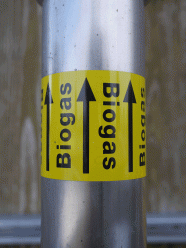Biogas Production
Managing Risks to Reap Rewards

With interest in clean, renewable energy on the
rise, the biogas market is poised for a period of
strong growth in the coming years. According to a
2012 Pike Research report, global revenue is
projected to double from $17.2 billion in 2011 to
$33.1 billion by 2022. But as new production comes
on line, owners and operators should take into
consideration not just the opportunity, but the
risks as well.
Biogas is produced by anaerobic digestion, or the
decomposition of organic waste in an oxygen-starved
environment. It is typically composed of about 50
percent methane and must be upgraded or purified for
transportation fuel applications. The process begins
in an anaerobic digester, which is a controlled
environment where bacteria work to break down the
organic waste (also called feedstock), and turn it
into biogas and an organic fertilizer byproduct.
Biogas recovery systems, meanwhile, help to reduce
methane emissions by capturing the methane that
otherwise would have been released into the
atmosphere and converting it into energy.
Biogas facilities, however, present a number of
potential risks for property damage as well as risks
to the health and safety of workers and visitors. In
2012, for instance, a digester used to produce
biogas at an Oregon dairy farm caught fire,
resulting in an estimated $250,000 in damage.
By taking steps to properly construct and maintain
biogas facilities, owners and operators can not only
increase the reliability of the facility, they can
also greatly reduce the risk of loss and injury.
A Growing Market
The biogas market may be a small part of the overall
bioenergy sector, but it is expected to grow
quickly. In its Biogas Opportunities Roadmap
released last August, the U.S. government discussed
its efforts to increase the use of biogas and reduce
methane emissions. As part of its biogas efforts,
the government plans to use existing programs as a
vehicle to enhance the utilization of biogas
systems, leveraging over $10 million in research
funding to enhance the economic viability and
benefits of biogas systems. The government also will
review opportunities to overcome barriers toward
achieving a robust biogas industry. In addition, a
Biogas Opportunities Roadmap Working Group will
collaborate with industry professionals to publish a
progress report in August 2015.
More than 191 biogas sites are already operating on
farms and about 1,500 more are at wastewater
treatment plants, according to the American Biogas
Council. With the proper support, more than 11,000
additional biogas systems could be deployed,
according to the Roadmap.
Potential Biogas Risks
Unlike other types of renewable energy, such as wind
and solar, biogas facilities generate flammable gas
and use a controlled environment as part of the
production process. These factors increase the
potential for property damage resulting from
accidents, fires and explosions and threaten the
health and safety of workers and visitors. For
example, digester equipment and surrounding property
could be damaged if the controlled environment
explodes. Similarly, workers or independent
contractors may be injured when working in confined
spaces or from contact with toxic gasses or oxygen
deprivation. Without proper PPE (personal protective
equipment) requirements and safe work practices,
these same workers could also be exposed to
pathogens that could cause illness and latent
diseases.
Biogas facilities should be designed and constructed
with both safety and production capabilities in
mind. These facilities should have a robust
confined-space entry program, even for small,
farm-based biogas facilities. The facilities must
also have the proper controls to ensure flammable
gases are properly managed
Equipment should be properly maintained and well
protected. A predictive and preventative maintenance
program should be implemented for all equipment,
especially for equipment critical to the plant's
operation. Critical, hard-to-replace spare parts
should be kept on hand so that any problem can be
resolved quickly without significant downtime. The
equipment should be frequently inspected and cleaned
as necessary.
Even when maintenance best practices are followed,
gas leaks that could lead to fires and explosions
remain a real possibility. To identify problems
quickly, methane detectors should be installed,
along with smoke and heat detection systems with
callout alarms to provide early warning. Fire
suppression systems also should be installed in
critical areas of the facility.
To limit the potential for damage, owners and
operators should consider segregating critical
assets, such as the engines used in biogas systems,
so that they are not all located in one room. By
segregating assets, it may be possible to limit
losses in the event of an engine fire. Equipment
also should have an automatic shut-off in case of
emergency and should not have an automatic restart
feature.
The buildup of too much pressure, or conversely a
vacuum condition within the bioreactor, is another
concern for owners/operators to consider. Digesters
should have a minimum of two pressure release
devices to prevent either an explosion or implosion
of the tank and these devices should be manufactured
and certified according to a recognized national
standard. The relief device set points should be
within the designed pressure rates of the associated
tanks. In addition, digesters should have a flare
system to burn off excess gas.
The benefits of biogas systems are clear. A viable
biogas industry can help boost the economy and
provide a reliable source of renewable energy while
reducing greenhouse gas emissions, according to the
Roadmap. However, biogas production is not without
risk. But those risks can be managed with the proper
planning and maintenance.
###
Aaron Kalisher, vice president, commercial market
segment specialist, Loss Control Services for the
Chubb Group of Insurance Companies, is based in
Warren, New Jersey and can be reached at
akalisher@chubb.com. Craig Bierl, an assistant vice
president and senior energy and risk specialist,
loss control, for Chubb in Chicago, Illinois, can be
contacted at
cbierl@chubb.com.
Copyright © 1996-2015 by CyberTech, Inc. All rights reserved.
To subscribe or visit go to: http://www.energycentral.com
To subscribe or visit go to: http://www.energybiz.com
http://www.energybiz.com/article/15/04/biogas-production?utm_source=2015_04_03